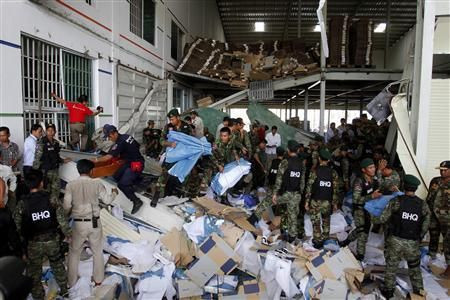Shoe Factory Collapses In Cambodia: Another Bangladesh Situation?

A shoe factory in Cambodia collapsed on workers early Thursday morning, killing at least two employees and injuring at least seven.
While most reports have confirmed two deaths at the scene, other reports are claiming that up to six have died as a result of the factory collapse.
The Cambodia disaster is the most recent case of fatalities as a result of substandard building infrastructure in the clothing industry in Asia. The search for victims in the recent factory collapse of the Rana Plaza building in Bangladesh came to an end earlier this week, with the death toll reaching 1,127. The tragedies in Bangladesh and now Cambodia are a reminder of the dangers of poorly constructed factories and sweatshops in developing nations.
The Phnom Penh factory, which makes Asics sneakers, had about 50 employees inside when the ceiling caved in, police officials confirmed. According to AP, heavy equipment that was being stored on a higher level was the cause for the collapse. Rescuers combed through the debris for several hours.
“We were working normally and suddenly several pieces of brick and iron started falling on us,” 25-year-old Kong Thary said, crying as she recalled the disaster.
According to Chea Muny, the head of a trade union for factory workers in the area, the collapsed structure is part of a factory complex that opened just a year ago. The building was used mostly for storage, but also had a small space for some production, which is why some employees were inside.
The factory is owned by a Taiwanese company called Wing Star, producing the Japanese brand’s sneakers for export to the United States and Europe.
Garment production in developing Asian countries has always been contentious for many human rights groups, which rally for higher wages and better working conditions. While subpar working environments are not news in the area, the shocking amount of factories that continue to operate despite hazards has gained media attention.
Roughly 500,000 people work in the more than 500 garment factories in Cambodia. Economically, the garment export industry is crucial for the southeast Asian nation. The industry is Cambodia’s biggest export earner, shipping roughly $4 billion worth of domestically made goods to the U.S. and Europe last year.
“Garment factories in Cambodia do not meet international safety standards,” Rong Chhun, the president of the Cambodian Confederation of Unions, told Al-Jazeera.
It was not until the Bangladesh factory collapse that international clothing brands agreed to fund safety upgrades in several Bangladesh factories. Though their garments were not produced at the Rana Plaza building, several European brands, like Spanish Zara, owned by Inditex SA (MCE:ITX) and Swedish H&M (STO:HM-B), have signed a five-year agreement promising they would finance upgrades at the factories in Bangladesh that produce their apparel.
© Copyright IBTimes 2024. All rights reserved.





















